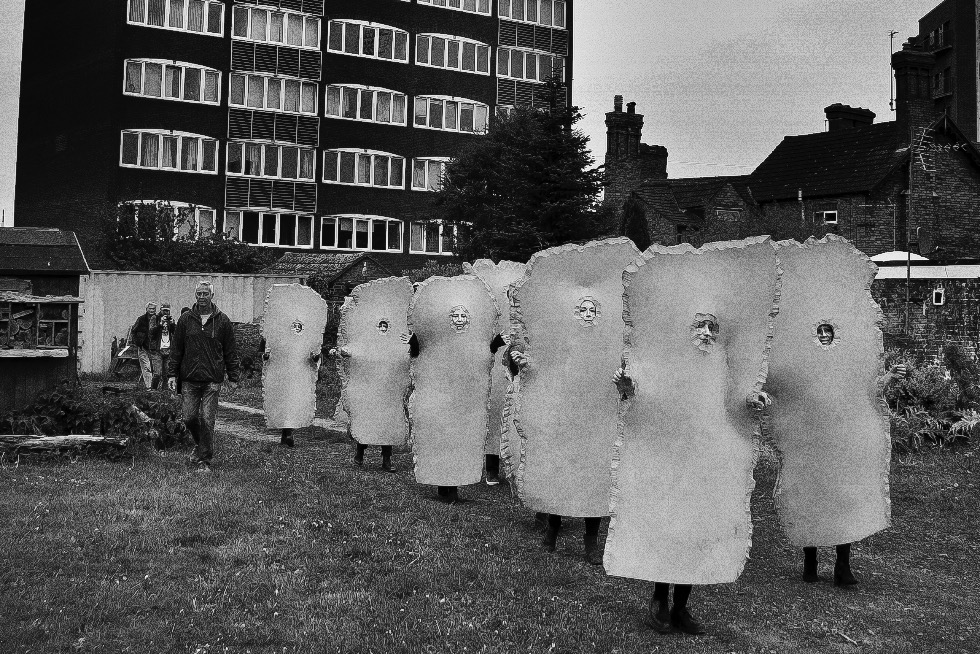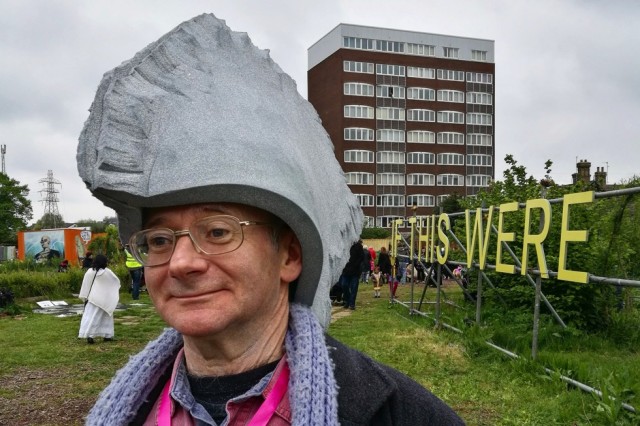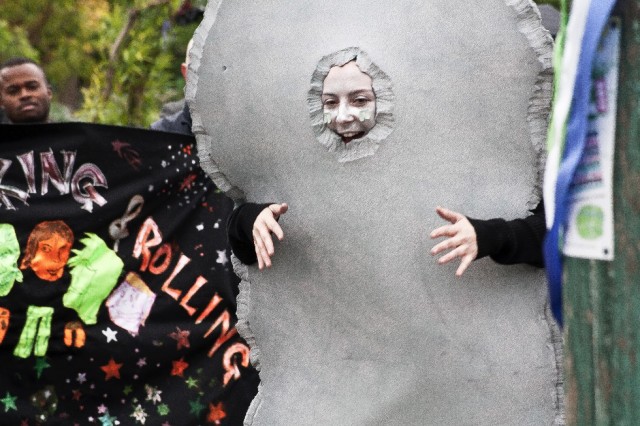“Art might be quite a ridiculous thing to be doing”: New Henge Heritage And The Reinvention of The Peterborough Stone

Unhenged? Wayne Burrows discusses folk traditions, belief systems and speculative evidence with the artists behind Metal Peterborough’s New Henge Heritage…
There’s an episode of Father Ted where a senior cleric visits Craggy Island to perform a ceremony that will transform an unimpressive local landmark, The Holy Stone of Clonrichert, into a “class two relic” on Vatican orders. The inherent absurdity of mystical significance granted by bureaucratic decree to a random object in the landscape drives much of the humour, even as the episode also hints at a deeper truth: that the beliefs which flourish around even the most spectacular prehistoric structures, from Avebury to Stonehenge, depend on similar theatrics and suspensions of disbelief.
Despite the authentic prehistory of their construction, it’s arguable that the meanings we invest in monuments like these remain a by-product of the 18th and 19th centuries. Stonehenge is inextricably, if paradoxically, entwined with the roots of modernity, especially in art, where the stones’ early public image was largely shaped by artists like John Constable and William Blake, taking their own cues from writers like James MacPherson and Edward Williams (better known as Ossian, the invented Scots-Gaelic author of a supposedly ancient epic, and Iolo Morganwg, the brilliant forger of an intensively researched but almost entirely fictional Druidic history).
For Arianne Churchman and Chloe Langlois, the artists behind New Henge Heritage at Metal, Peterborough, both the influence of comedies like Father Ted and the business of speculative evidence plugging the many gaps in our actual knowledge about the purpose of ancient sites are at the heart of their project. As Churchman points out: “We’ve taken a very speculative approach, but archaeology and history are quite speculative in themselves. The difference is that we’re not really trying to answer anything and have actually worked quite hard to avoid answering anything.”
That avoidance of “answering anything” took the form of an extensive research programme to construct a tenuous knowledge base around the diminutive neolithic stone that sat, mostly overlooked, on a small patch of green outside Peterborough’s town museum. “We spent several months working with academic archaeologists and an archeo-astronomer, as well as fringe believers in crystals, shamanism and magic, to construct beliefs around the stone”, says Langlois. “I like the fact that at the end of our project everybody involved still only knows exactly the same amount about the Peterborough Stone as they knew when we started – which is nothing at all.”
Individually, Langlois and Churchman make work encompassing painting, costume and object-making, sound, performance and video. Langlois often draws from the subcultures of professional wrestling, pop astrology and fringe religious belief, while Churchman explores and re-invents vernacular folk customs and rituals, with a particular emphasis on the traditions of her native Suffolk. Common ground lies in an insistence that neither professes expert knowledge, only a basic enthusiasm for and fascination with the fields their work references.
“I’m interested in the relationship between art and magic, those relationships between mimetic practices in art and similar things in folk tradition”, explains Churchman, “but I don’t think I really believe in those things, deep down, even though on some level I would like to, and do wish I was able to become a practising witch or something. As it is, I end up making work as an outsider to the things I make my work about. We both do a lot of research but I think we’re making our own rituals within the belief system of contemporary art, not the belief systems of the practices we’re referencing – and there are just as many weirdly inexplicable beliefs in art as anywhere else.”

“That’s it”, says Langlois. “I think I really want to believe in the reality of the stuff I’m interested in, but I’m not sure I always do, even though contemporary art has a lot of the same structures, unfounded beliefs and hierarchies as all these other subcultures we’re drawn to.”
Langlois and Churchman first collaborated on Green Man Crossing in 2013, acting out a reinvented folkloric rite in the form of an elaborately costumed pilgrimage along a route through Nottingham city centre that took in a range of Green Man surrogates: a medieval misericord in St Stephen’s Church; an appropriately branded ale in a local pub; a host of pedestrian crossings and a statue of Robin Hood, among other things. They ended the performance with a symbolic mutual decapitation and another ale in the bar of The Salutation Inn, a reputedly haunted 800 year old pub.
Their interest in the Peterborough Stone emerged partly from the comically diminutive size and presence of the ancient relic itself, which clearly appealed to their shared sense of the absurd, and partly from Churchman’s prior involvement in a project called Harvest Wain Procession in 2015. For Harvest, Churchman had put together a formation team of volunteer Molly Dancers, dressed in green smocks and fabric horse heads, to re-enact a traditional Harvest Wain procession. Having built relationships with both Metal’s Peterborough outpost and The Green Backyard, a community project in the city, she and Langlois put together a proposal to create a new ritual for the Peterborough Stone.
“The stone itself is so underwhelming that I can honestly say I didn’t notice it during the entire time I worked on Harvest”, says Churchman. “I must have stared intently at it many times but never noticed it. It must have been considered important once because efforts were put into preserving it when it was moved to the museum from its original site in the 19th century. But there’s no real indication of what its importance was, and maybe that’s the great thing about unrecorded history. The potential is wide open for these kinds of objects and sites to be seen in magical ways, as inherently transformative in some way.”
“I think artists are often drawn to things that don’t have a lot of fixed or clearly known facts surrounding them”, agrees Langlois, “because that allows you the space and freedom to muck around with what little fragments and bits of information are known and do something new.”
“It’s what attracted people like Bruce Lacey and Jill Bruce to stone circles and rituals in the sixties and seventies”, Churchman adds. “I think the story goes that they had an exhibition and on their journey to the opening happened to see Stonehenge and immediately grasped the possibilities of working with sites like that. So they began making performances and films, using these slightly mysterious places as transformative sites for themselves. I don’t think Bruce Lacey ever minded being seen as funny or ridiculous at the same time as he was being absolutely serious.”

“The brilliance of people like him, or in a very different way, someone like Marko Pogačnik, of the OHO Group in Slovenia, is that their work can be all these amazing and contradictory things at once”, says Langlois. “That’s what appeals to us about someone like Bruce Lacey – he’s an artist and enthusiast whose work is impossible to categorise. He’ll create this strange ritual for the breakdown of his marriage and on one level it’s ridiculous and hilarious and on another it’s really intense and powerful. And he is quite happy with that basic contradiction.”
This merging of comedy and art influences is made explicit not only in the general look of the stone costumes worn by the New Henge Heritage performers – hinting as much at The Mighty Boosh as Jeremy Deller’s bouncy castle rework of Stonehenge, Sacrilege (2012) – it’s also upfront and centre aboard The Megalith Bus, a karaoke-fuelled coach trip from Nottingham to Peterborough with comedian J.B. Carter acting as “Tor Guide” throughout. At the performance itself, the foam stones have a surreal and comic presence, offset by the ritualistic vocal drones of their performance.
“There’s a kind of lateral thinking that is shared by both art and comedy”, says Churchman. “You’re not working with normal structures or ways of thinking in either. There’s a need to go off at unexpected or strange tangents and find yourself doing slightly ridiculous things. The context is different but the approaches and ideas often aren’t all that far apart.”
“Both are also about using lots of layers”, adds Langlois. “Comedy is full of things that have multiple meanings or rely on making weird connections between things you wouldn’t normally put together. We look at people like Matt Berry or Vic Reeves and they seem to us to sit very well alongside the work of contemporary artists like Shana Moulton and Bedwyr Williams.”
“I also find a lot of art that takes itself too seriously ridiculous, but not in the way that makes other kinds of ridiculous work interesting”, says Churchman. “But perhaps it isn’t a good idea to think about this too much, because if that’s the case you’re going to make yourself look ridiculous whatever you do. Perhaps we just accept that art might be quite a ridiculous thing to be doing.”
Both suggest that their attraction to working across these cultural boundaries and hierarchies reflects “a kind of medieval sensibility,” a fascination with a period when distinctions between fine art and craft, magic and logic, alchemy and science, seriousness and humour, all seemed fluid: “The barriers seem to be right down which is why I think we’re both drawn to that liberating aspect of medievalism”, says Churchman. “You get the same thing in folk cultures – these are places where all the usual divides between fine art and the vernacular are irrelevant in quite spectacular ways.”

“I’ve always been drawn to medieval imagery and art”, adds Langlois, “and that is there even when I look at contemporary things, like [the WWF’s] Ultimate Warrior. I think of him as some extraordinary figure who has stepped out of a medieval painting showing a pantheon of ancient Gods having cocaine-induced breakdowns and that’s exactly why he interests me. Mostly I just pick up on whatever is around me that has this feeling of something eccentric or strange; an atmosphere that I’m drawn to for reasons I’m not always sure I understand myself.”
Which returns us to the cultural reinvention of ancient sites during the 18th century. Medievalism was the inspiration for Gothic fiction, for a renewed interest in Arthurian legends and imaginary Druidic histories, all in a context where folk ballads and nursery rhymes, by no means always authentic, were brought decisively into the canon. Much of this is retrospectively seen as a response to political and social transformations in a society on the cusp of industrial revolution. Perhaps comparable impulses to seek out new meanings, rituals and stories for our own fragmented, post-Imperial, increasingly digital and automated cultures were only to be expected.
Which is not, it should be noted, to take it all too seriously. There’s also little doubt that the authors of Gothic fiction, like the collectors of ballads and nursery rhymes, were as conscious of the absurdity and inauthenticity of their activities as artists today. As Langlois notes of Bruce Lacey’s ease with his own contradictions, we might also think of a visionary figure like William Blake, engaged in conversations with the angels roosting like pigeons in Peckham’s trees, as equally happy to embrace both the meaning and absurdity inherent in his position: “Without Contraries is no progression” was how he phrased it in The Marriage of Heaven and Hell (1789).
For Langlois and Churchman, similar contradictions hold. The ritual of the Peterborough Stone manages to be simultaneously ridiculous and meaningful. “I think everyone who took part had his or her own quite personal reasons”, says Langlois. “What was interesting was that when we were preparing to do our dawn performance we were all laughing hysterically – but from the moment we left Metal to walk through the empty streets to the stone, and through the whole performance, absolutely everyone was very serious, very quiet, and it did have a completely different atmosphere once it actually began.”
“I think there was something that switched in people”, explains Churchman. “You know at that point you are actually performing a ritual, even if you might not believe in it. But you are involved in what you are doing, you are in a different kind of mental state. And the audience at sunrise, at 5.30am in Peterborough, is obviously very small, if not actually non-existent. We didn’t have to worry about looking stupid or ridiculous, because we were all just performing for this stone and the sunrise and the very few people there who are all invested in it in some way.”
Wayne Burrows
See Arianne Churchman’s performance HORSE-PLAY* on Saturday 5 August 2017, 11–11.30pm, at Nottingham Castle Museum & Art Gallery; part of her HORSE-PLAY solo exhibition, open 16 September to 31 October 2017
Wayne saw New Henge Heritage at Metal, Peterborough, between March and May 2017
See more on the artists websites: For Arianne Churchman and Chloe Langlois
Top three images (details) courtesy Julian Hughes; last image courtesy the artists, Arianne Churchman and Chloe Langlois. With thanks





